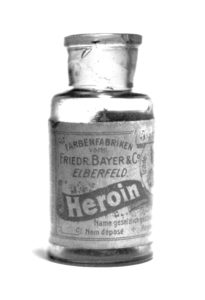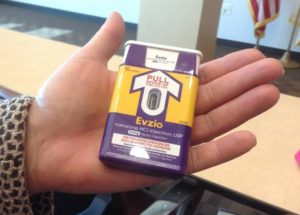 Pharmaceutical companies are constantly on the search for the “Wonder Drug “that will work wonders and make money. Surprisingly, the pharmaceutical giant that created the wonderful drug “Aspirin” also introduced heroin drug to the world. While looking for a cough suppressant that didn’t have many side effects, like the commonly used morphine and codeine at the time, Bayer stumbled upon Heroin. First created by a British chemist in 1874, and cooked up again, the boss was interested in mass production. Bayer sold the heroin drug by the truckloads in 1898. Free samples were shipped across the states to Doctors, and studies appeared in Medical Journals, by late 1899 Bayer was producing about a ton of heroin a year. Covering 23 countries, the drug was hooking users and reports of addiction and heroin withdrawal started appearing in late 1899. Aspirin was released to the public a year later, and Bayer got out of the heroin business in 1913. Heroin is processed from morphine, a naturally occurring opiate extracted from the seedpod of certain varieties of poppy plants. The opium poppy has been cultivated for more than five thousand years for a variety of medicinal uses. Although Heroin is still flooding the streets of America today, it is not coming from large pharmaceutical companies. “Street heroin” is rarely pure and may range from a white to dark brown powder of varying consistency. Due to the impurities, these “cuts” are often sugar, starch or occasionally other drugs. Other forms of heroin like “Black Tar” is from Mexico, a less pure form of heroin, is more commonly found in southwestern America, and usually resembles sticky roofing tar. Heroin withdrawal is plaguing Americans, and heroin overdose is one of the leading causes of deaths in the current drug epidemic in America, and treatment for heroin is on the rise.
Pharmaceutical companies are constantly on the search for the “Wonder Drug “that will work wonders and make money. Surprisingly, the pharmaceutical giant that created the wonderful drug “Aspirin” also introduced heroin drug to the world. While looking for a cough suppressant that didn’t have many side effects, like the commonly used morphine and codeine at the time, Bayer stumbled upon Heroin. First created by a British chemist in 1874, and cooked up again, the boss was interested in mass production. Bayer sold the heroin drug by the truckloads in 1898. Free samples were shipped across the states to Doctors, and studies appeared in Medical Journals, by late 1899 Bayer was producing about a ton of heroin a year. Covering 23 countries, the drug was hooking users and reports of addiction and heroin withdrawal started appearing in late 1899. Aspirin was released to the public a year later, and Bayer got out of the heroin business in 1913. Heroin is processed from morphine, a naturally occurring opiate extracted from the seedpod of certain varieties of poppy plants. The opium poppy has been cultivated for more than five thousand years for a variety of medicinal uses. Although Heroin is still flooding the streets of America today, it is not coming from large pharmaceutical companies. “Street heroin” is rarely pure and may range from a white to dark brown powder of varying consistency. Due to the impurities, these “cuts” are often sugar, starch or occasionally other drugs. Other forms of heroin like “Black Tar” is from Mexico, a less pure form of heroin, is more commonly found in southwestern America, and usually resembles sticky roofing tar. Heroin withdrawal is plaguing Americans, and heroin overdose is one of the leading causes of deaths in the current drug epidemic in America, and treatment for heroin is on the rise.
Ways Heroin is Done.
The Heroin drug can be injected, smoked, and sniffed. The powder forms of the drug are sniffed through the nose and the effects are almost immediate. Like other opiates, heroin is a sedative drug that slows body functioning. Depending on the amount used, and the route it was administered the effects usually last several hours. Use of heroin can result in nausea or vomiting. The users of heroin describe the effects of the drug as a warm, relaxation and a detachment like feeling. Injecting the drug poses a much greater risk of an overdose due to the large amount of heroin entering into the bloodstream at once. Smoking and snorting heroin can also result in heroin overdose, especially if a non-tolerant user ingests a large amount of potent heroin. Symptoms of a heroin overdose include slow and shallow breathing, convulsions, coma and possibly death. Using Needles to inject Heroin is very dangerous, not only because of the drug, but the potential of HIV. Many addict share “dirty” needles when injection heroin and it can spread deadly infections like HIV, Hepatitis B and C.
Overdoses.
Anti-reversal overdose drugs such as Naloxone can reverse the effects of an overdose if administered in time. Naloxone is a medication called an “opioid antagonist” used to counter the effects of opioid overdose, for example morphine and heroin overdose. Specifically, naloxone is used in opioid overdoses to counteract life-threatening depression of the central nervous system and respiratory system, allowing an overdose victim to breathe normally. Naloxone is a nonscheduled (i.e., non-addictive), prescription medication. Naloxone only works if a person has opioids in their system; the medication has no effect if opioids are absent. Although traditionally administered by emergency response personnel, naloxone can be administered by minimally trained laypeople, which makes it ideal for treating overdose in people who have been prescribed opioid pain medication and in people who use heroin and other opioids. Naloxone has no potential for abuse. Naloxone may be injected in the muscle, vein or under the skin or sprayed into the nose.
Withdrawal
People who use heroin regularly are likely to develop a physical dependence. Heroin Withdrawal symptoms (“cold turkey”) may begin within 6 to 24 hours of discontinuation of the drug; however, this time frame can fluctuate with the degree of tolerance as well as the amount of the last consumed dose. Symptoms may include sweating, anxiety, depression, chills, severe muscle aches, nausea, diarrhea, cramps and fever. Heroin is highly addictive. Due to the powerful heroin withdrawal symptoms, those who are dependent on heroin should access medical detox in order to wean off the drug.
If you or a loved one needs help with a heroin detox in Texas, please contact us today.

Recent Comments